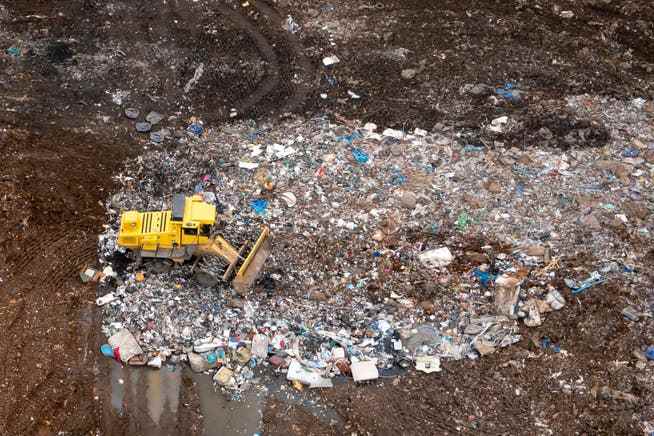Two financiers from Switzerland and Germany support Howells on his search for the lost treasure – but an important player stands in the way.
James Howells, the failed bitcoin millionaire.
For James Howells, any day that bitcoin soars is a bad day. And every day that the value of the cryptocurrency falls gives the 37-year-old Welshman some relaxation. It was the worst a year ago: On November 10, 2021, Bitcoin reached its all-time high of $68,763 during the day. The 8,000 bitcoins that James Howells dug up on his laptop at home 13 years ago corresponded to a theoretical value of around 550 million dollars. The so-called digging cost him next to nothing, apart from a huge amount of electricity.
Howells’ fortune is theoretical because the absent-minded IT expert disposed of the external hard drive on which his Bitcoin wallet is stored long ago during a clean-up campaign. He had once put them in a rubbish bag along with other junk. With that, he drove his car to the local rubbish dump in Newport, south Wales, where he threw everything on top of the rubbish heap.
As it later turned out, Howells had mistaken the mobile phone-sized hard drive for a second one on which he had not stored any data.
A few years passed before he noticed his mishap, which cost millions. Because after his initial curiosity about the then new cryptocurrency, he had lost interest in it. After mining his bitcoins in 2009, the course languished, the book profit for the 8000 pieces of the digital currency was in the range of a few dollars.
Increase in value by a factor of 80
That was to change abruptly in 2013. Over the course of that year, bitcoin rose in price by a factor of 80 and ultimately climbed above the $1,000 mark for the first time. It was only now that Howells remembered his hidden treasure – and soon realized that his Bitcoin fortune had accidentally ended up in the landfill. Without the bitcoin wallet, a type of digital wallet, it is impossible to gain access to the account.
“It really gets on your kidneys,” says Karl Wendekorn, “and every day anew.” Wendekorn is a German investor specializing in risky investments. Together with his business partner, the Swiss Hanspeter Jaberg, he heard about Howells’ mishap in 2013. Since then, the two have accompanied the Welshman on his search for the lost treasure. “I don’t see our role primarily as a financier, in this case I would describe us more as psychologists and coaches.”
They try to contain Howells’ anger and turn it into positive energy. In the meantime, the project to fish the discarded hard drive out of the landfill has developed into an independent small business with all the trimmings: business plan, personnel recruitment, risk assessment.

This landfill site in Newport, south Wales, is where Howells suspects his bitcoin fortune.
Artificial intelligence and robotic dogs
This year, the three put together a team of eight experts from all over the world. Also with the use of artificial intelligence, the 110,000 tons of waste at the Newport landfill are to be systematically scoured for the accidentally discarded hard drive. The search operation is to be monitored day and night with so-called robot dogs that circulate around the area. Because there is a great concern that strangers will end up grabbing the hard drive with the hidden treasure.
“In principle, we know exactly in which section and also in which layer of the landfill we have to search,” says Karl Wendekorn. If city officials followed the cleanup plan, the area can be narrowed down based on the date of Howells’ fateful cleanup. “Exactly three people have this knowledge: Howells, my business partner Jaberg and I,” adds the German financier.
So far, however, the Newport city authorities have been uncooperative. They claim that such a search operation is not responsible for reasons of environmental protection – apparently there are fears that toxic contaminated sites will reach the surface. That’s why James Howells and his team want to convince the city authorities with a master plan. The entire landfill is to be excavated, contaminated sites are to be cleared and part of the waste is to be recycled. In the end, wind turbines and solar systems are to be installed on the cleaned landfill to generate clean electricity.
In addition, Howells and his financiers are offering each of Newport’s 128,000 residents $50 worth of bitcoin if the hard drive is actually found. “It’s a win-win situation for everyone involved,” Wendekorn is convinced. “We would leave the landfill in better condition than it is today.”
According to the master plan, the whole campaign would take three years and cost over 10 million dollars. “We have the investors for the venture capital together,” says Wendekorn, “we could start tomorrow.” Investors are not even deterred by the risk that the hard drive could have been damaged. Experts put this risk at 10 to 20 percent.
Wendekorn does not want to reveal how large the share of the investors in the profit would be – if the hard drive were actually found and were still intact. “It also depends on how the value of bitcoin develops.”
After various slumps since last spring, the price for the most important cryptocurrency has currently settled at around $16,000. While that’s significantly less than a year ago, Howells’ portfolio would still be worth almost $130 million.
